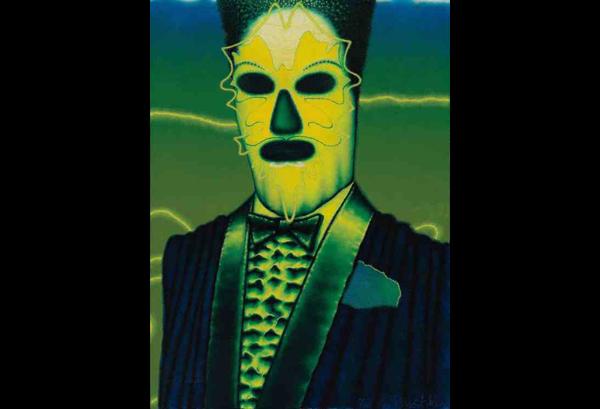The Ashmolean Museum presents Ed Paschke: Visionary from Chicago, 1968–2004. The exhibition is the third in the museum’s series of shows of post-war and contemporary art presented in collaboration with the Hall Art Foundation (USA), with an additional four works that have been lent by the artist Jeff Koons. The exhibition is also the third at the museum to be curated by Sir Norman Rosenthal.
Not many people in the UK know who Ed Paschke was – The Hall Art Foundation was even stopped going through customs, and literally quizzed about the artist by staff, avidly googling questions about the Paschke, to fire at Hall Foundation staff in case the work was a cover for a smuggling ring – but when looking at the artist’s positively effervescent works it is instantly recognisable why Jeff Koons would own some of Paschke’s work.
There is also the little known fact that Koons studied with the artist, and was hired as Paschke’s studio assistant in 1974, the artist has contributed an interview with exhibition curator, Sir Norman Rosenthal, to the exhibition catalogue, in tribute to the artist.
Paschke was part of a group of artists known as the Chicago Imagists who emerged in the 1960s. The artist was strongly influenced by media imagery and popular culture – newspapers, magazines, advertisements, film and television, creating brilliantly coloured, provocative and surreal paintings of circus freaks, tattooed ladies, transvestites, and wrestlers, exploring the underbelly of urban life and a dark side of Pop Art.
It could be said that Paschke was before his time; a Pop Artist employing imagery that may be commonplace today – but presumably caused a bit of a stir at the time of creation; presenting dystopic figurative paintings – ‘Noirish’ Pop Art with a sense of the flamboyant – the artist’s subject matter was always exotic. The wrongly perceived shallowness of Warhol’s celebrity obsession was replaced by the fascination for what society would perceive as grotesque, and bizarre [at the time of painting]. portraits of tatooed individuals, or the sexually ambiguous, a fascination for the social outsider.
Paschke’s painterly practice reflects a hybrid of different, even disparate elements from the language of 20th century painting. The artist is a Formalist hidden beneath the veneer of a Pointillist ,or maybe a Photo Realist with an uncontrollable tendency toward Abstraction, and Surrealism simultaneously. The artist’s lurid photo-based paintings depict the characters from the other side of life, the unusual, the individual, and the strange – characters that are always neon and provocative.
The principle of representational painting is subverted; Paschke blurs the traditional divide between figure and ground, creating work akin to a contemporary ‘neon pointillism’, atomizing the divides with a hybrid practice of finely wrought painting techniques – but Pop Art is always at the foreground for the artist – even though Paschke’s treatment of his subject differs drastically from that of the artist’s New York contemporaries, Andy Warhol, James Rosenquist, and Robert Rauschenberg.
It is the artist Jeff koons who shares with Paschke the practice of combining ‘low-life themes’ with the ambitions of ‘high art’ – from cartoon characters to super heroes, drawing from the Pop sensibilities of 20th century iconography, while reflecting modern media’s transformative ability to make everything an icon. But with Paschke we don’t have the Campbell Soup Can, or Michael Jackson, but luminous, almost ‘thermo-imaged’ characters, sometimes spooky, and other times truly outsider, or alternative – but the characters – as with the artist’s paintings – are always iconic – icons of 20th century dark Pop from the streets of Chicago. Ed Paschke was the original Pop Art provocateur.
Ed Paschke: Visionary from Chicago, 1968–2004 – Ashmolean Museum – until 5 July 2015
Words: Paul Black Photo: courtesy of Ashmolean Museum, Oxford © Artlyst 2015 all rights reserved

